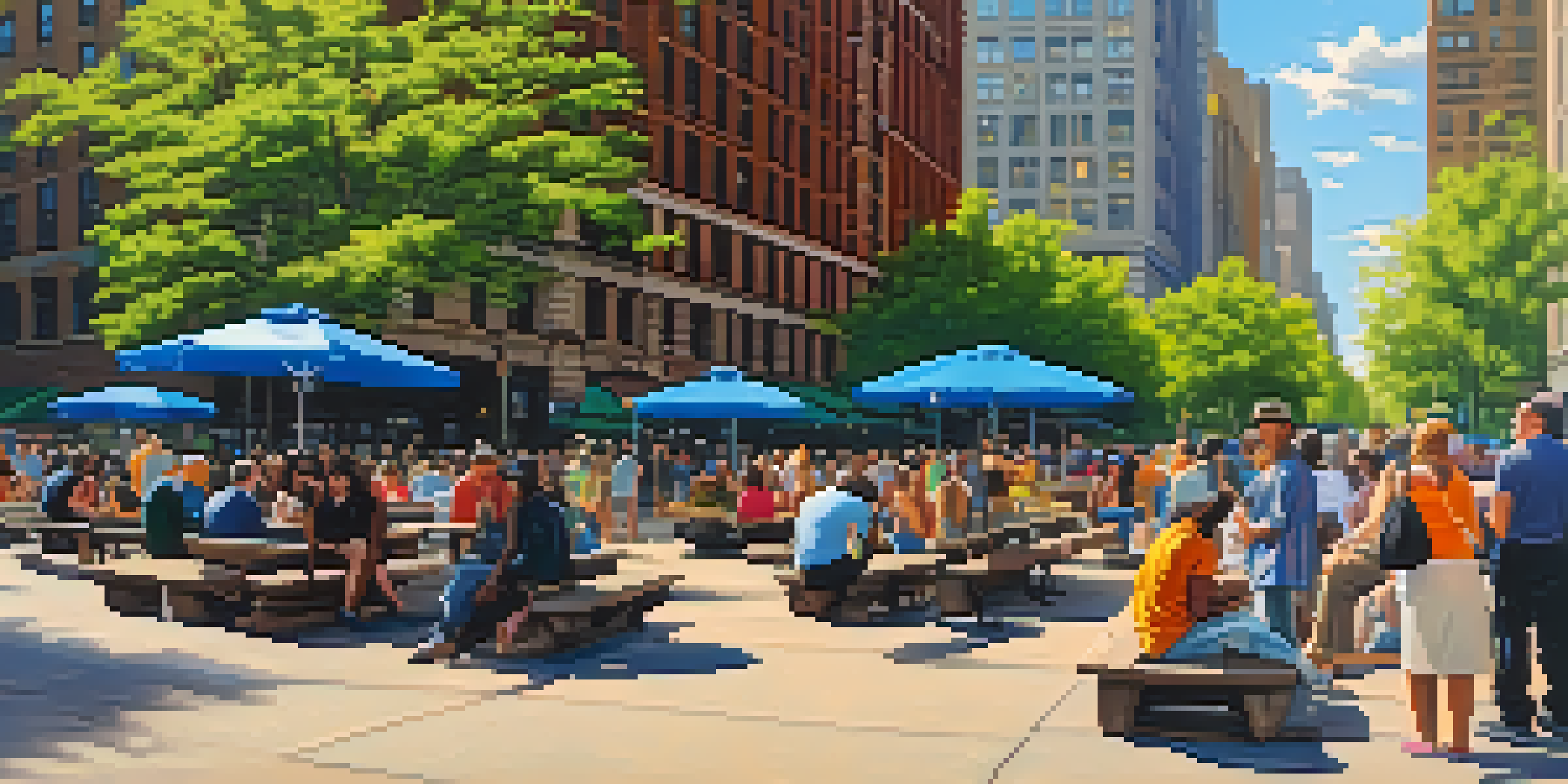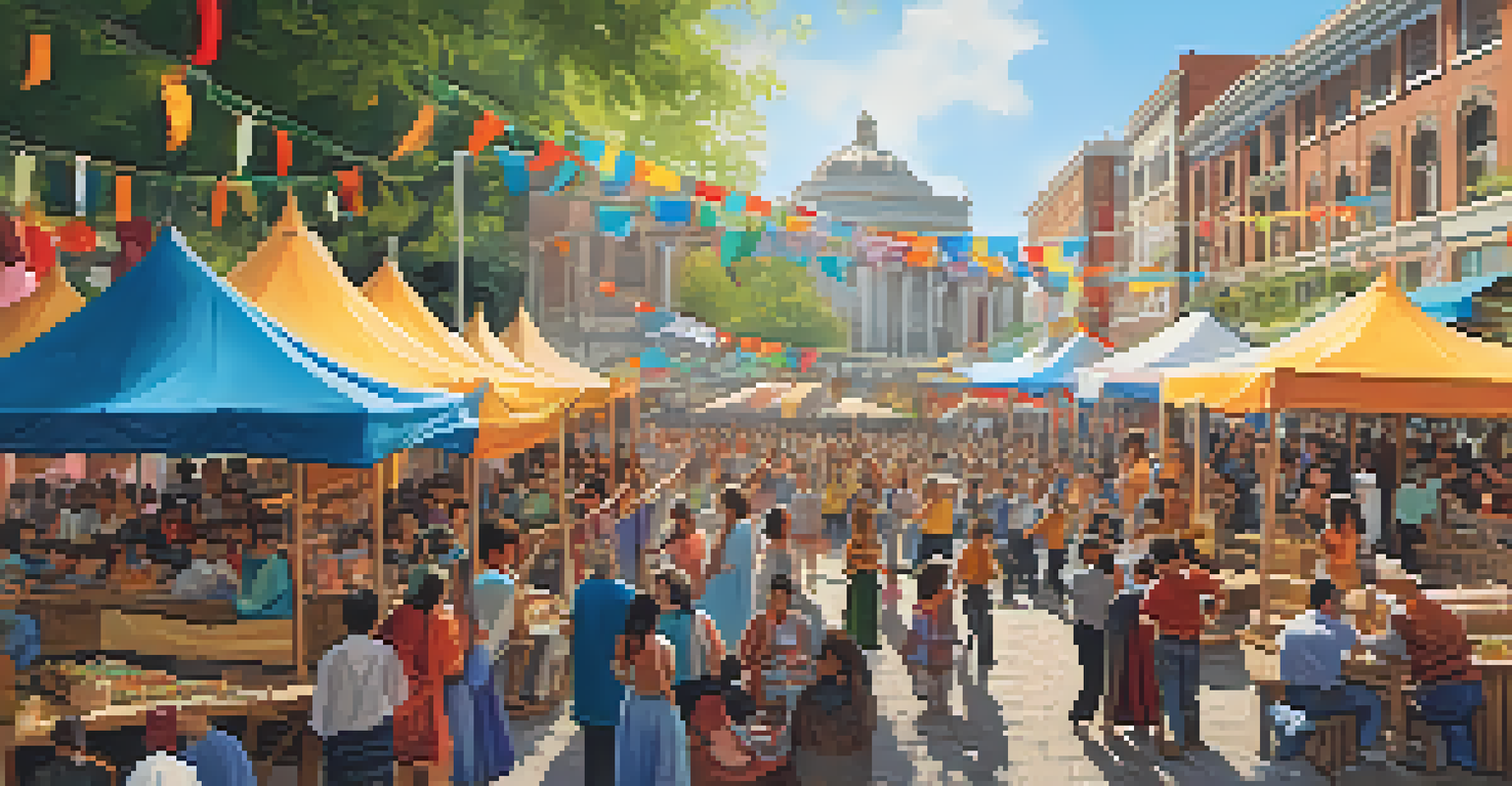How Public Squares Enhance Social Interactions in NYC

The Heart of Community: What are Public Squares?
Public squares serve as the vibrant heart of urban communities, especially in bustling cities like New York. These spaces are designed for everyone, providing a common ground where people from diverse backgrounds can gather. Think of them as the living rooms of the city—places where life unfolds and stories are shared.
Public spaces are the lungs of our cities, providing fresh air for the spirit and the soul.
In NYC, squares like Union Square or Bryant Park are more than just patches of green; they are vital social hubs. They often feature benches, art installations, and sometimes even food vendors, creating an inviting atmosphere. Whether it's a quick lunch break or a weekend event, these spaces encourage spontaneous interactions among strangers.
As technology continues to shape our lives, public squares remind us of the importance of face-to-face connections. They offer a break from the digital world, inviting people to step outside and engage with their surroundings. In essence, they become stages for the rich tapestry of urban life.
Cultural Events: Bringing People Together
One of the most engaging aspects of public squares is their role in hosting cultural events. From outdoor concerts to art fairs, these gatherings create opportunities for social interaction and community bonding. For instance, the SummerStage concerts in Central Park attract thousands, blending music with socializing.

Events in public squares are often designed to reflect the diversity of the city. They allow for cultural expression, where local artists, musicians, and performers showcase their talents. This not only enriches the community but also fosters a sense of belonging among attendees.
Public Squares Foster Community Bonds
Public squares act as social hubs where diverse individuals gather, share experiences, and create connections.
Moreover, these events often encourage participation from different demographics, bridging gaps between generations and cultures. When people come together to enjoy art or music, they share experiences that can lead to meaningful conversations and connections.
The Role of Design in Fostering Interaction
The design of public squares plays a crucial role in encouraging social interactions. Thoughtful layouts, including open spaces, seating arrangements, and accessible paths, create environments where people feel comfortable gathering. Imagine a square with ample seating—it's more likely to attract groups and spark conversations.
The best part of a city is its public spaces. They give us the opportunity to meet, interact, and enjoy our community.
For example, the redesign of Times Square transformed it from a chaotic intersection into a pedestrian-friendly plaza. This change not only improved safety but also invited people to linger, chat, and enjoy the vibrant atmosphere. The layout encourages a flow of movement, making it easy for people to meet others.
Additionally, incorporating greenery and art can enhance the appeal of these spaces. Nature has a calming effect, while public art often serves as a conversation starter, inviting people to share their thoughts and experiences. Design matters; it shapes how we interact with each other and our environment.
Public Squares as Safe Spaces
Public squares often serve as safe spaces for individuals to express themselves freely. This is particularly important in a city as diverse as New York, where people come from various backgrounds and cultures. Here, individuals can gather without the constraints of formal settings, fostering open dialogue and understanding.
These spaces provide a platform for activism and community engagement. For instance, rallies and demonstrations often take place in public squares, giving voice to those who wish to advocate for change. Such events facilitate connections among like-minded individuals, reinforcing a sense of community.
Design Enhances Interaction Opportunities
Thoughtful design of public squares, including open spaces and seating, encourages social interactions and community engagement.
Moreover, the presence of security measures, such as lighting and police patrols, enhances the feeling of safety. When individuals feel secure, they are more likely to engage in social interactions, further enriching the community fabric.
The Importance of Accessibility in Urban Spaces
Accessibility is a vital aspect of public squares that significantly influences social interactions. When these spaces are designed to accommodate everyone, including those with disabilities, they become truly inclusive. Ramps, tactile paths, and wheelchair-friendly seating ensure that all community members can engage.
In New York City, initiatives to improve accessibility in public squares have made a noticeable difference. For example, the redesign of Madison Square Park included features that cater to individuals with mobility challenges, making it easier for everyone to enjoy the space. This inclusivity fosters a sense of belonging among residents.
When people feel welcome in public spaces, they are more likely to connect with others. Accessible squares encourage participation from a broader audience, enriching the community with diverse perspectives and experiences.
The Impact of Green Spaces in Urban Areas
Green spaces within public squares offer much more than just aesthetic appeal; they play a significant role in social interactions. Parks and gardens provide a natural setting for people to relax and unwind, creating a backdrop for spontaneous conversations. Imagine sitting on a bench surrounded by greenery; it naturally invites others to join you.
The presence of trees and plants not only enhances the beauty of these areas but also promotes mental well-being. Studies show that spending time in nature reduces stress, making people more open to socializing. In NYC, places like Washington Square Park are renowned for their lush landscapes, drawing locals and tourists alike.
Accessibility Promotes Inclusion
Ensuring public squares are accessible to everyone fosters a sense of belonging and enriches community dynamics.
Moreover, green spaces often host community gardening and educational programs, further encouraging social bonding. These initiatives not only beautify the squares but also instill a sense of stewardship among participants, connecting them to their community and to each other.
Public Squares: A Reflection of Local Identity
Public squares often reflect the unique identity and culture of their neighborhoods. They serve as canvases for local artists and represent the history and traditions of the community. This connection to local identity enhances pride among residents and fosters strong community ties.
For example, the murals and sculptures found in Harlem's public squares celebrate the area's rich cultural heritage. These artistic expressions invite conversations about history, culture, and shared experiences, enriching the social fabric of the community. They remind everyone of their shared story and collective journey.

In this way, public squares become not just physical spaces, but symbols of community identity. They bring people together around a common narrative, encouraging interactions that strengthen bonds and foster a sense of belonging.
Conclusion: The Future of Public Squares in NYC
As urban landscapes evolve, the importance of public squares continues to grow. They are essential for fostering social interactions and nurturing community connections in an increasingly digital world. Looking ahead, it’s vital to prioritize the development of these spaces to ensure they cater to the diverse needs of the population.
Community involvement in the planning and design of public squares can lead to vibrant, inclusive spaces. By engaging residents in discussions and decisions, cities can create areas that reflect their needs and aspirations. This collaboration helps ensure that public squares remain relevant and welcoming for all.
Ultimately, public squares are not just physical locations; they are vital to the social health of communities. By enhancing these spaces, we can cultivate connections, celebrate diversity, and foster a sense of unity in the heart of New York City.